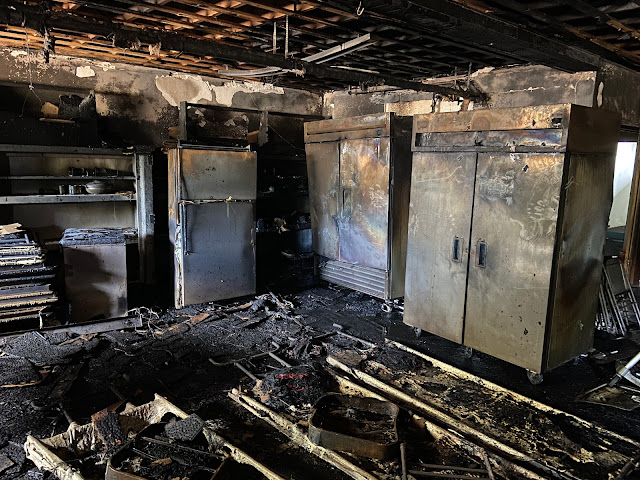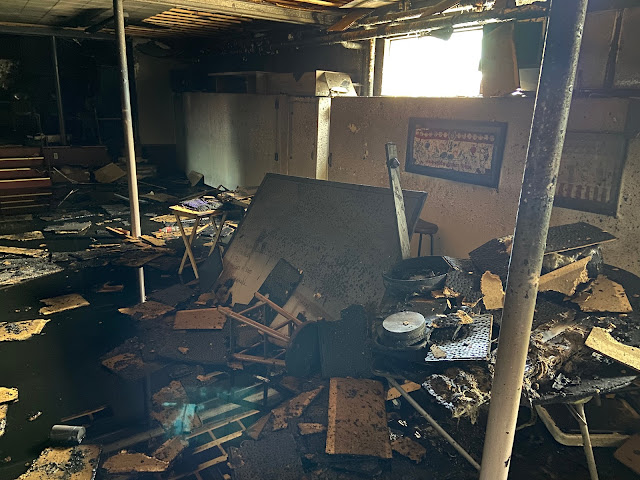Temple Fire and Gaman ( 我 慢)
“The first time I ever
heard that word [Gaman] was when I was standing in line, waiting to use the
latrine. As a child, this was sheer torture. But my mother looked down at me
and said, ‘George, gaman.’ She wanted me to endure, with fortitude and
dignity, the injustice of having to wait in the cold even to go to the
bathroom. Throughout our time in the camp, the spirit of gaman is what buoyed
us, even in the darkest of hours. By holding our heads up high, and carrying
on, they could not take from our basic humanity.”
--George Takei (History Channel Interview, Feb. 10, 2017)
As I reflect on the July 8th fire in our temple basement, the Japanese word “gaman”, referred to by George Takei in the opening quote, comes to my mind.
Photo: Three refrigerators in the IOBT temple basement after the July 8th fire. The fire was started by a bad electrical outlet in this area.
Today,
Idaho-Oregon Buddhist Temple and the Sangha are facing their own disaster aftermath.
We are devastated by the loss of personal property in the basement of the
temple. So much has been consumed in the fire and destroyed beyond repair or
salvage. Sangha Taiko drums, musical
instruments, and stands are gone or irreparably damaged. Kimonos were
destroyed. Photo albums are gone. Cooking utensils that were specially designed
and made for the temple’s needs are gone. Even our beloved bingo machine and
display board were melted.
Photo: Temple basement social hall after the fire. Most of the items in the basement were damaged beyond repair from fire, smoke, and water.
Practicing gaman will help us to move forward. Why is gaman important? How does gaman fit in with our Shin Buddhist practice? There are 3 practical ways in which this perspective can help us.
First, our Buddhist
Teachings remind us of impermanence. Everything changes. Nothing stays the
same. Even our temple is not safe from change. In a blink of an eye, a fire
changed everything. The fire serves to remind us that this temple is a precious
treasure that we should appreciate every single day. We should not wait for a
disaster to remember all the causes and conditions that made this temple in
Ontario, Oregon possible. Remembering all that had to happen to make the temple
possible and that change will happen, no matter what, we practice gaman,
persevere, and move on with our temple services and activities as best we can.
Second, those causes and conditions remind us of our interconnectedness with others. We have experienced an outpouring of support from our Sangha and from the community at large. Northwest District ministers and temple members have reached out with words of support and donations. Community members have offered rooms to hold services. Sangha Taiko is receiving donations of drums and money to help them return to their performances. Knowing that we have all this support helps us to persevere and move forward.
Photo: This picture, taken on the day of the fire, shows that our precious Amida Buddha statue on the altar, the Gohonzon (御本尊) of our main hall, remains intact!
Another Japanese phrase that I want to apply to our current situation is a proverb, Nanakorobi yaoki (七転び八起き), which literally means “fall seven times, stand up eight”. This proverb reminds us that life is a bumpy road. You will be knocked down many, many times. To be able to overcome unfortunate circumstances, we need to stand up one more time. We must patiently persevere (practice gaman). Our temple has withstood many bumps in the road. Our Issei and Nisei have withstood many hardships and obstacles, but they stood up one more time. It is our turn to do the same.

Photo: July 8, 2022, It must feel so good to take off the heavy protective clothing and Oxygen tanks after all that hard work!
During
this 75th Anniversary year, Idaho-Oregon Buddhist Temple has much to
be grateful for, despite the fire and the resulting destruction. We have a long
road to recovery before us. We know that with the support of everyone far and
near, we have the resilience to push forward. Our Issei and Nisei would have
done nothing less. GAMAN!
( 我 慢!)
NAMO AMIDA
BUTSU
Rev. Kathy
Chatterton
Assistant Minister, Idaho-Oregon Buddhist Temple









Comments
Post a Comment